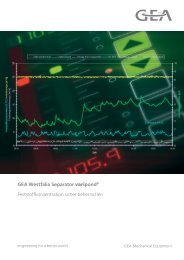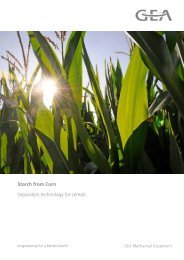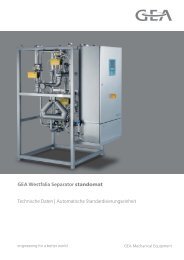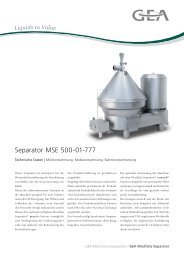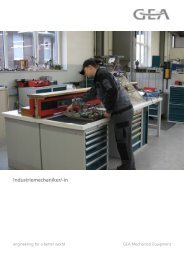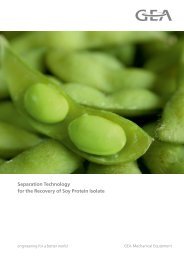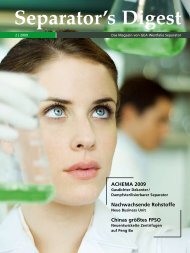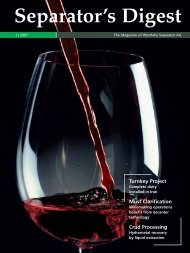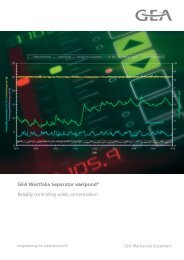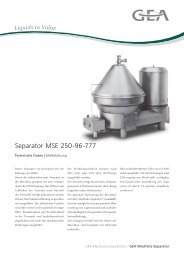Separator's Digest - GEA Westfalia Separator Group
Separator's Digest - GEA Westfalia Separator Group
Separator's Digest - GEA Westfalia Separator Group
Create successful ePaper yourself
Turn your PDF publications into a flip-book with our unique Google optimized e-Paper software.
are En Vogue<br />
FrUiT jUicE anD FrUiT pUrEE prODUcTiOn<br />
wiTh DEcanTErS<br />
however, a high-quality end product not<br />
only requires perfect raw materials:<br />
correspondingly high-quality processing is<br />
just as important. This means that lower<br />
quality and rotten constituents of the raw<br />
products have to be removed. crushing and<br />
mash treatment are mandatory and have to<br />
be used in accordance with the specific type<br />
of fruit. in many cases, peeling and stoning<br />
of the fruit are recommended for making<br />
quality products.<br />
Rapid juicing, short<br />
processing times<br />
an attempt is made to avoid the use of heat<br />
and enzymes. Long processing times have<br />
an even greater negative impact on quality.<br />
after fruit has been crushed, enzymes such<br />
as pectinases and oxydases are released;<br />
these result in a biochemical change in the<br />
juice.<br />
Lengthy exposure to atmospheric conditions<br />
results in a not necessarily desired change in<br />
aroma and colour. For instance, in the<br />
production of apple juice, the aroma is<br />
released after the apple has been crushed.<br />
in the initial phase, the concentration of key<br />
components increases, and the aroma<br />
becomes more intense. however, over a<br />
period of time, these components change<br />
or disappear. This process is normally<br />
stopped by means of pasteurisation<br />
involving heat treatment. ideally, the juice is<br />
heated ten minutes after it has been<br />
crushed. in order to be able to achieve this,<br />
it is essential for the fruit to be juiced quickly,<br />
for instance with a decanter. The very short<br />
processing time also has the major<br />
advantage that the microbic contamination<br />
time is minimised. This results in a low<br />
bacteria process.<br />
Decanters as the core<br />
element of process<br />
technology<br />
when a decanter is used, the mash is<br />
conveyed through a feed tube into the bowl<br />
which is rotating at high speed. The<br />
centrifugal force in the bowl results in the<br />
solids with a higher specific gravity being<br />
separated from the mash, and the solids<br />
then collect on the wall of the bowl. The<br />
lighter phase, the juice, collects above the<br />
solids. The solids scroll rotates at a slightly<br />
higher speed in the bowl of the horizontal<br />
scroll-type centrifuge. The solids are<br />
discharged out of the bowl by the scroll as a<br />
result of the slightly higher differential<br />
speed. The solids first enter the conical part<br />
of the decanter bowl, where they are further<br />
juiced before being discharged out of the<br />
bowl. This juicing process is based on the<br />
process of the solids being lifted out of the<br />
liquid layer and being subject to downstream<br />
press dewatering (in the case of compressible<br />
solids, such as most fruit mashes) or<br />
dewatering by means of capillary flow (in<br />
the case of incompressible solids).<br />
ideal processing conditions can be created<br />
by the choice of suitable technical parameters.<br />
This is achieved by ensuring that the<br />
technical parameters are consistent with<br />
the process environment. The mash processing,<br />
and in particular the crushing<br />
process, is vital in most cases.<br />
Adjustable consistency<br />
Because smoothies are a mixture of fruit<br />
juice and purees, it is important for the right<br />
solid content of the individual fruit<br />
components to be set. in certain cases, it is<br />
important to retain a “coarse“ consistency.<br />
a homogeneous structure, such as that<br />
achieved by means of a homogeniser, is<br />
desired only in exceptional cases. The<br />
concentration of the solid phase in the liquid<br />
phase is controlled by the various machine<br />
parameters which can be adjusted during<br />
operation. The concentration can be<br />
increased or decreased depending on the<br />
phase in which the required substances<br />
occur in increased concentration.<br />
accordingly, the decanters should be fitted<br />
with devices for torque-dependent control<br />
of the differential speed, variable adjustment<br />
of pond depth in ongoing operation and<br />
product discharge under pressure by means<br />
of a centripetal pump.<br />
raTE capaciTy carEFULLy<br />
The market requires high quality fresh fruit juices and fruit<br />
purees, smoothies. This requires a processing line which meets<br />
the requirements of high quality processing. A processing<br />
capacity of 800 kg / h has proven to be a good scale.



